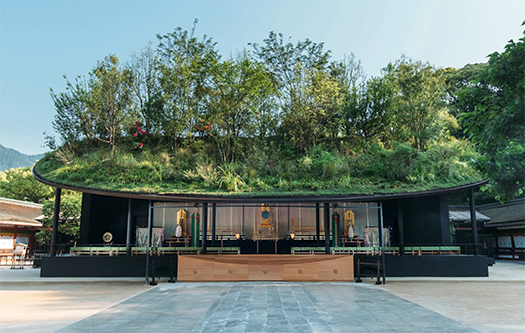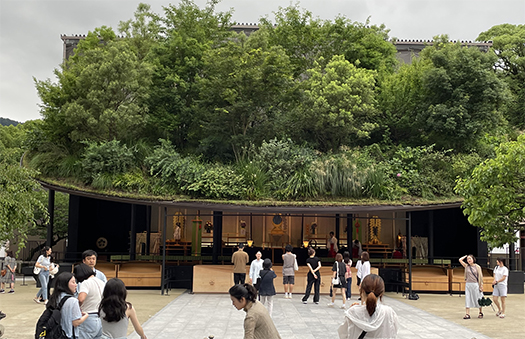
大阪万博が迫ってきていますが、一向に「盛り上がり」が感じられません。北海道から見ているとメディアが一斉に反万博の動きに出ているように見え、ひたすらディスろうとしているように思われてならない。
そうした、社会を盛り上げようというムードの退潮はどうも全世界的な現象とされていて、その根源にはこれまでの経済の基盤資源、石油など社会基盤へのコストアップ圧力があるという。その部分のコスト上昇が直接的に生活コストの上昇を招いて、世界全体で既存の政治体制に動揺をもたらしているという説。そのコアには脱炭素の急すぎる展開があって、日本でも電気料金の上昇などに結果している。生活苦。
そういった生活苦がときの政権への反発を加速させた結果、アメリカでもフランスでも政権基盤の弱体化が進行している。日本でも同様であり「いまどき万博かよ」といったムードが支配的なのかもしれない。
おっと、万博のシンボル的な建築家・藤本壮介氏のことに触れようとしたら、世界情勢分析に飛び火してしまった(笑)。太宰府天満宮の本殿の建て替えにあたって、「仮殿」の建築について藤本壮介氏がデザインしたのが写真。
最近の都市デザインではよくこういった「緑化」技術が活用されている。一種のブームなのでしょうか。既成の建材への行き詰まり感があって、もてはやされている側面もあるのでしょうが、屋根緑化などの技術の向上がこのように反映していると思われる。

太宰府天満宮には5−6年前に行っていましたが、今回は非常に目新しい仮殿で驚かされていた。わたしが知る限りではこういった「拝殿」というのは初見。神さまの世界でも、革新の気風を感じさせてくれてすばらしい。単純に楽しませていただいていました。というか、この仮殿参観後、周辺の木々の様子に見入っていましたので、このデザインのインパクトは自然景観へのめざめのきっかけとしては大きかったかと。
日本の神社信仰は宗教というよりも「慣習」に近いと言われますが、木造建築としてはその基盤的な「正統」デザインを歴世伝承させてくるには非常に大きな力になった。たぶん伝統木造技術が日本独自で延命し続けてきたのには、各神社の式年遷宮のような建て替えが継続してきたことが文化として大きい。
北海道の建築工務店が木造技術伝統をしっかり継承しながら、同時に高断熱高気密の技術発展にもきわめて前向きに取り組んできた状況を先日紹介の「新建ハウジング」記事では書きましたが、伝統が発展していく様は、まことに喜ばしい。
太宰府天満宮の姿勢も素晴らしいと思いました。
English version⬇
Sousuke Fujimoto’s “Temporary Hall of Dazaifu Tenmangu Shrine
Shrine architecture showing both sides of tradition and innovation. The “Shikinen Sengu” at Ise seems to show both tradition and innovation in Japanese wooden construction techniques. The aim of this design is good. …
The Osaka Expo is coming up, but I don’t feel any “excitement” about it. From my vantage point in Hokkaido, it seems as if the media are all working together in an anti-Expo movement, and are trying to discredit the event.
Such a retreat from the mood of social uplift is apparently a worldwide phenomenon, and the root of it is said to be the pressure to increase the cost of social infrastructure, such as oil, which has been the basic resource of the economy. The theory is that rising costs in these areas are directly leading to higher living costs and upsetting existing political systems throughout the world. At the core of this is the too rapid development of decarbonization, which has resulted in higher electricity prices in Japan, for example. Living pains.
The same is true in Japan, where the “now is not the time for everything. The same is true in Japan, where the prevailing mood may be, “Expo ’70 nowadays?
I was going to mention the symbolic architect of the Expo, Sousuke Fujimoto, but that turned into an analysis of world affairs (laugh). The photo shows Sousuke Fujimoto’s design for the construction of a “temporary shrine” for the reconstruction of the main shrine of Dazaifu Tenmangu Shrine.
This kind of “greening” technology is often utilized in recent urban design. Is this a kind of boom? It may be that there is a sense of deadlock with existing building materials, and that this is partly a result of the popularity of this technology, but it is also likely to be a reflection of the improvement in roof greening and other technologies.
I had been to Dazaifu Tenmangu Shrine 5-6 years ago, but this time I was surprised by a very new temporary hall of worship. As far as I know, this is the first time I have seen such a “worship hall. It was wonderful to see the spirit of innovation even in the world of the gods. I was simply amused. After visiting the temporary shrine, I was looking at the surrounding trees, so I think the impact of this design was significant as a trigger for my interest in the natural landscape.
Japanese shrine worship is said to be more akin to “custom” than religion, but as a wooden structure, it has been a very powerful force in the transmission of its foundational “orthodox” design to successive generations. Perhaps the most significant cultural factor in the continued longevity of traditional wooden construction techniques unique to Japan has been the continuous rebuilding of shrines, such as the shikinen-sengu (ceremonial relocation of shrines).
I wrote in an article in Shinken Housing the other day about how a Hokkaido construction company has been working positively to develop highly insulated and airtight technology while at the same time continuing to carry on the tradition of wooden construction technology, and I am very pleased to see the tradition developing.
I thought the attitude of Dazaifu Tenmangu Shrine was also wonderful.
Posted on 7月 2nd, 2024 by 三木 奎吾
Filed under: 日本社会・文化研究







コメントを投稿
「※誹謗中傷や、悪意のある書き込み、営利目的などのコメントを防ぐために、投稿された全てのコメントは一時的に保留されますのでご了承ください。」
You must be logged in to post a comment.